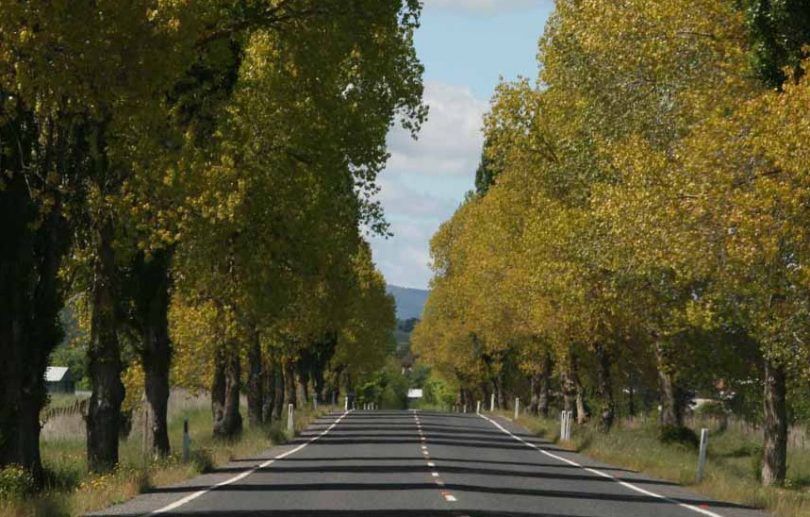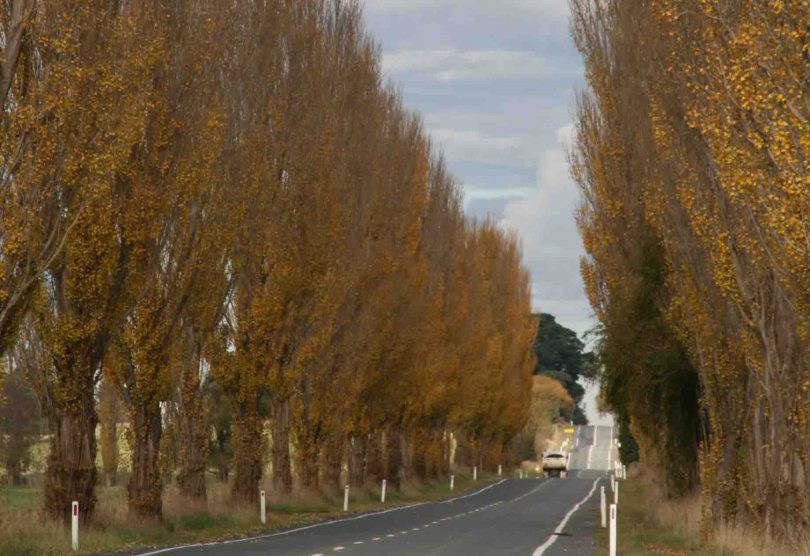
The northern entrance to Braidwood is flanked by historic golden poplar trees. Photo: Alex Rea.
The longstanding saga of Braidwood’s historic highway entry lined with golden and Lombardy poplar trees is progressing to the next stage. Last week, Transport for NSW emailed some residents with plans to replace the ageing poplars with new saplings.
The poplars have been deemed a roadside hazard because they are too close to the highway, and there have been several fatalities on the straight stretch of road over the years.
Kings Highway is the main route between Canberra and the NSW South Coast. It carries a high volume of traffic, particularly on weekends and during summer holidays. The corridors of trees on both the northern and eastern approaches to Braidwood are located very close to travel lanes.
Transport for NSW is finalising planning for a safety upgrade, including installation of guardrails along the northern approach to Braidwood to protect motorists from roadside hazards, and planting of newly grown saplings in a corridor 6.5 metres from the roadside to preserve an avenue of trees in this location in the future.
The eastern approach to Braidwood will be looked at as part of future funding, with Kings Highway considered the priority.
In the email to residents, Transport for NSW said it is “progressing with safety improvements on the Kings Highway at Braidwood later this month. We have listened to the community and have designed a plan that will maintain the tree-lined avenue while also improving road safety.
“The existing avenue of trees are historically significant to the community of Braidwood, however they pose a safety hazard to motorists by being close to the road. The project will include the installation of guardrails along both sides of the Kings Highway at the northern approach to Braidwood.

New poplar tree saplings which will replace the ageing avenue of trees that line the Kings Highway on entry to Braidwood. Photo: Transport for NSW.
“Advancements in roadside barrier technology have reduced the amount of room required behind the guardrails, allowing us to keep trees along the avenue while improving safety for motorists.
“The existing poplars are approaching the end of their natural lives. The planting of 100 new poplar saplings behind the existing avenue of trees will take place. This will maintain the heritage significance of the original trees while also improving road user safety. We will inform the community when work is due to start.
“Following advice from NSW Health, and existing social distancing measures, we are no longer able to involve the community in the tree planting as originally planned. To make this project milestone available to the community, we will be recording the planting of the trees and uploading the video to the project website.”
The window of opportunity for the tree planting is during autumn, so it is expected to be done in the next month.
A potted history of Braidwood’s poplar trees
Braidwood’s heritage-listed poplar avenue is a memorial to the 25-year reign of King George V from 1910 to 1936.
The avenue of poplar trees on the northern entrance to Braidwood is listed on the Register of the National Estate. It comprises poplars lining the Kings Highway, extending 1km south from the entrance to Braidwood Showground, 2km northwest of Braidwood.
The avenue’s statement of significance says: “The popular avenue demonstrates high local historical value as a commemoration of an event of importance to the community of Braidwood, and an illustration of the importance many in the community attributed to the British monarchy. The avenue also represents tangible evidence of the efforts of various residents of Braidwood to strengthen a sense of community in the district.
“In 1925, the then Municipal Council undertook various improvement works within the Braidwood township, including the planting out of Ryrie Park using plant material donated by the Forestry Department and Botanic Gardens. Continuing this spirit of community celebration in 1936, the northern approach road, from about the showground entrance, was planted with Lombardy and golden poplars. The avenue was to specifically celebrate the 25th year of the reign of King George V. The northwestern part of the avenue incorporates an old windbreak of large Monterey pines which frame the entrance to Braidwood Showground. The windbreak was probably planted in about the 1880s or earlier.”
In 2004, the then Eastern Capital City Regional Council (ECCR Council) established a working group on the poplars due to community concern for their fate. At that time, six of the condemned poplars were removed under a works order from the former Roads & Traffic Authority (RTA).

The avenue of Lombardy poplar trees on the eastern side of Braidwood. Photo: Alex Rea.
A report condemned around half of the 90 trees, but residents requested an independent assessment be done, and that the speed limit be lowered from 100km/h to 80km/h.
“Imposing a restrictive speed limit, as some residents suggested, doesn’t solve the problem of the condemned trees falling because speed wouldn’t make much difference if one of the trees actually fell on a car,” said the ECCR Council at the time.
The community formed the People’s Poplar Front, headed by Hans Hofmann, and more than 1000 signatures were collected in support of the trees. The group also raised funds for a new report.
The report found that 19 trees were deemed necessary for removal due to their unsound structure, and 26 should be reassessed in the near future, while 49 were considered suitable for retention.
The People’s Poplar Front called on members of the community to Adopt-a-Poplar, and on National Tree Day in 2005, the then Palerang Council, the RTA and the local group invited everyone to help in the planting of new trees in the Commemorative Poplar Avenue on Kings Highway, between Station Street and Deloraine Lane, in a row further from the road than the existing trees.
Sadly, these new trees all perished in the dry summer as they were not looked after by the council, which had disallowed residents to ‘adopt’ them and care for them.
In March 2013, the 100km/h speed limit on the Kings Highway on both approaches to Braidwood was reduced to 80km/h.
Transport for NSW said, “Although there has been a reduction in the number and severity of crashes since the introduction of the 80km/h speed zone, the roadside hazards still pose a risk to motorists.”
In 2013, Transport for NSW harvested cuttings from the existing golden poplar trees. The saplings have been growing steadily and are now at a height suitable for replanting.







